Blog
Which is the Best Music Streaming Service for Artists?
18 Feb '2022
Producers and musicians who are ready to distribute their music have a lot of choice of where to put it. Here we’ll give you the positives and negatives behind each major music streaming service
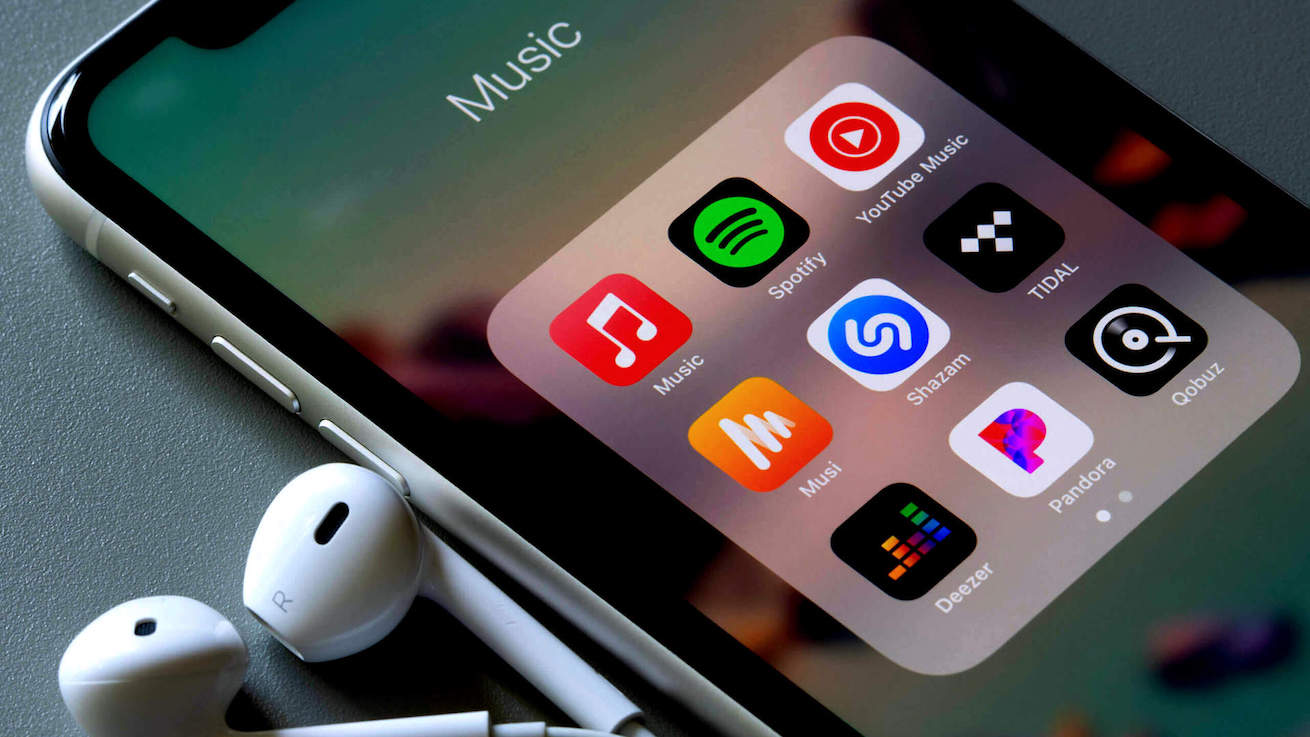
Streaming services are constantly upping their game and new players are always joining the fight. You probably have your own favourite service for streaming music as a listener, but what are the advantages and disadvantages of the various options for the creators? In this article, we’ll give you the information necessary to help you choose the best music streaming service for your needs as an artist.
A streaming service's user base is an influential factor for artists who want their music to reach a large audience. The big players like Spotify, Apple, and Amazon provide millions of users with instant access to music uploaded to their platforms. For other streaming services to compete, they need to offer different benefits to capture the attention of artists and listeners alike.
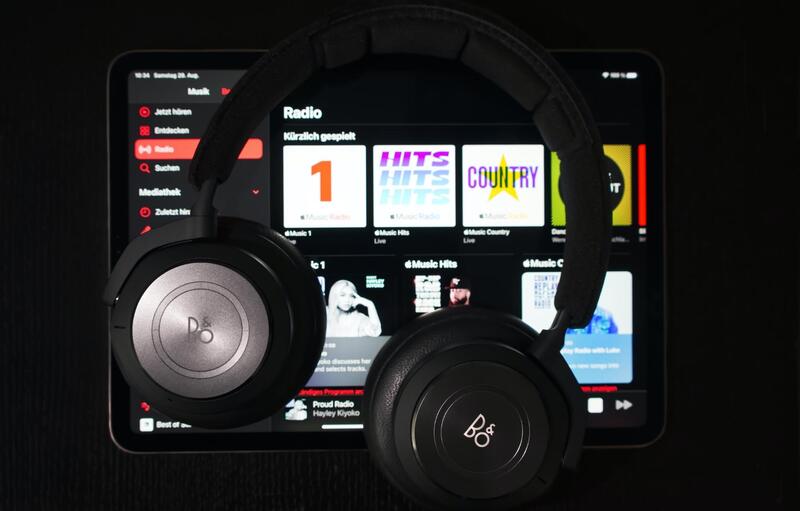
Which are the best music streaming services for artists?
In this article, we’ll give you an informed breakdown of the following services, and we’ll provide some discussion on each one too. Here’s what’s coming up…
• Spotify
• Apple Music
• Tidal
• Amazon Prime Music and YouTube Music
• Beatport
• Bandcamp
• SoundCloud
• How to decide the best music streaming service for you?
• However you distribute, create with Loopcloud
Spotify
Thriving on community and shareability for users and artists, Spotify promotes the sharing of music with an excess of options through social media or messaging apps, plus a follow feature that encourages fans to keep up to date with their favourite artists. Followers are informed about upcoming releases and shows, and the artist is then more likely to appear in their individually tailored playlists.
Spotify playlists themselves are finely tuned by the platform’s internal algorithms, with artist radio tools and daily personalised mixes encouraging a continuous search for new music. Users will find it easy to stumble across new music, aggregated by their tastes, and have the option to add it to their own custom playlists. All of this means that if your band releases shoegaze music for example, there’s a good chance that fans of that genre will come across it – as long as it’s good!
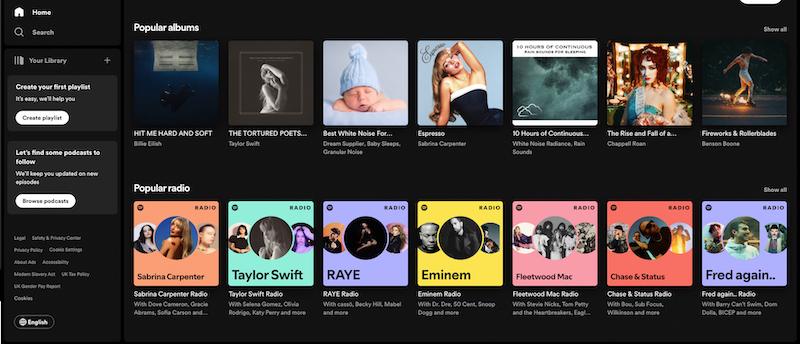
Spotify successfully brings back the nostalgia of making mixtapes or burning CDs for friends. Custom playlists can easily be shared or listened to simultaneously on multiple devices via Group sessions. Spotify really comes into its own as a platform that promotes a culture of exploration and sharing.
One of the key benefits of releasing music on Spotify is its integration with social media platforms. Trends on TikTok have changed the role of Spotify playlist curators. Individuals who have gained a mass following on TikTok by sharing their custom playlists now rival tastemakers such as labels, radio stations and playlist curators. Artists can reach hundreds of thousands of plays if they land a spot on a TikTok curator’s playlist.
Spotify’s Artists app helps musicians and labels manage their profiles. Here, you can keep track of listener information, plan promotional campaigns, hyperlink to merchandise, and pitch releases to editorial playlists. Spotify also has unique features that allow you to go the extra mile as a creative. For instance, you can upload a 3-8 second vertical video (or Canvas) to each of your songs that users can view on loop as they listen. Spotify also paired with Musixmatch Pro, allowing artists to get their lyrics published in sync with their music on the platform. Other platforms have followed suit with ‘For Artists’ and similar features – however, none currently compare with Spotify’s feature-packed app.
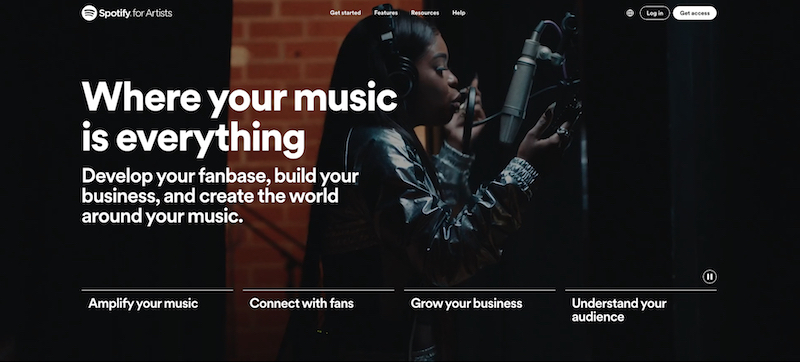
Spotify has received criticism for their audio quality of 320kbps in comparison to the HiFi, lossless audio (1411kbps) offered by their competitors. The Swedish streaming service has promised an upgraded subscription for better-quality audio, however, it was due in 2021 and still hasn’t been delivered. Consider whether you want your listeners to experience your music at the highest quality possible. If so, they will need to own an audio interface or DAC.
It’s also important to consider that Spotify’s financial returns per stream are one of the lowest at $0.004PPS. Clearly though, the platform has other benefits aside from audio quality and financial returns. The primary benefit of getting your music on Spotify is that it has the highest chance of being discovered. After all, the majority of today’s listeners are on Spotify. As an artist, weigh up what’s important to your release. Do you want to be discovered, or does your music need to be heard in the highest quality?
Pros of distributing your music with Spotify
• Promotes shareability with integrations across a wide range of social media platforms
• Algorithmic Playlists - Radio feature and personalised daily mixes to promote new music
• Editorial playlists to allow upcoming artists the chance to break through the noise
• Group listening sessions on multiple devices
• Offers an advanced dedicated app for artists to manage their profiles, track listeners, and pitch new music
• Highest listener population with the best chances of discovery
• More creative tools for artists, such as Canvas and Musixmatch Pro in-sync lyrics
Cons of distributing your music with Spotify
• Lower audio quality of 320kbps
• One of the lowest financial returns for artists at $0.004 per stream
Apple Music
A giant from the early days of digital music, stemming from the tried and trusted format of iTunes, Apple is still at the forefront of the industry. Their streaming service Apple Music integrates seamlessly with existing Apple consumers, hosting 24-hour live radio and location-based playlists. But how does it stack up for artists?
While Apple Music is home to a large user base, the connectivity and shareability of the streaming service can be seen as a downfall, especially for non-Apple users. Currently, you can copy and paste URL links of tracks and playlists to share them to others, but the receiver can only access the music if they are also an Apple Music customer. This is a drawback if you’re looking to maximise the spread of your music.
Hosting audience listening statistics like Spotify. Apple has you covered with their Artists app. Unfortunately, the platform isn’t as diverse as Spotify’s and excludes direct links to merchandise sales on artist pages and customisable canvas artwork. Apple Music does, however, also allow for in-sync lyric publishing through Musixmatch Pro. This means, if you’re an artist using Musixmatch Pro to distribute your lyrics, you can get them on both Spotify and Apple Music.
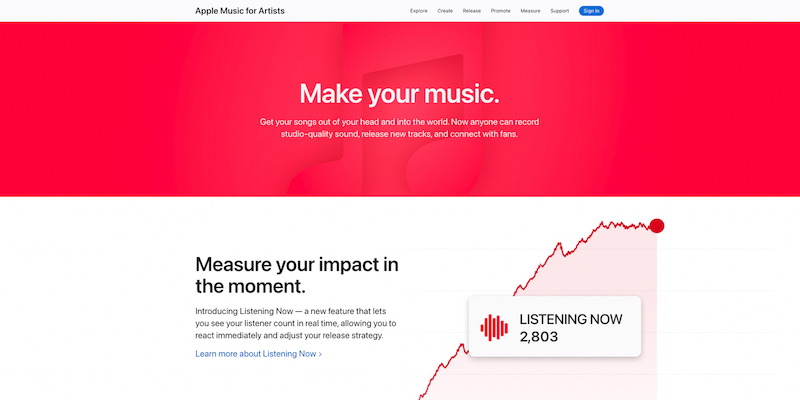
Unlike Spotify however, Apple Music excels in the realm of audio quality. Their lossless audio lets the listener experience your music in the highest quality, as it was intended to be heard – providing they have the gear to handle it! High-quality audio is exciting for artists who want to utilise the latest surround sound technology like Dolby Atmos. Apple boasts spatial audio for the AirPods Pro and AirPods Max, the most cost-effective way for consumers to experience surround sound audio at the moment.
Apple pays a respectable $0.01 per stream, which is more than other platforms. On average, Apple Music pays 2.63 times more than Spotify per stream. All in all though, artists are still being held to ransom somewhat, as business tycoons and major labels now own large shares of Spotify and Apple Music. What alternatives do artists have?
Pros of choosing Apple Music
• Offers 24-hour live radios and location-based playlists
• Offers a dedicated app for artists for audience tracking features
• Excels in audio quality and offers the latest surround sound technology for users
• One of the higher financial returns for artists at $0.01 per stream
• High compatibility and integration for iPhone users
Cons of choosing Apple Music
• Limited shareability with only URL sharing, and music can only be listened to by Apple Music customers
• Artists app features are limited compared to other platforms like Spotify
• Not as many listeners (by quite a large margin) compared to Spotify
Tidal
When Jay-Z bought the obscure Norwegian streaming service in 2015, he rebranded it as an ‘artist-owned’ streaming service that pushed back against other big-business streaming ventures. Tidal has encouraged change in a stagnant industry that many consider unfair for the creators.
Through Tidal’s two royalty initiatives, the platform empowers fans to choose which artists receive a percentage of their subscription fee. The ‘Direct Artists Payout’ royalty scheme gives 10% of Tidal’s premium subscribers’ membership directly to their most-listened-to artist. At the end of each month, the listeners receive notifications telling them which artist received their subscription fees. Even at the lower subscription tiers, artists receive more per stream than most other platforms, making it the highest-paying platform for artists.
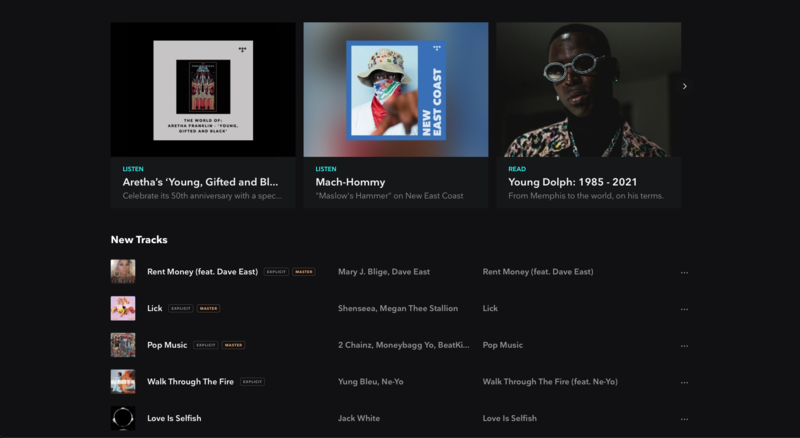
Tidal was planning to implement a ‘Fan-Centred Royalty’ system as a new model that delivered further royalties to listeners’ favourite artists, however, after announcing it to the world, they cancelled this feature without further public discussion. Unfortunately, although Tidall does promote more support for artists, and gives fans more power over who their money is going to, it still hasn’t been as successful as Jay-Z and other investors had hoped. Even though it’s probably the best candidate for artists, its slowed subscriber count means there are far fewer listeners on the platform overall. Especially, when compared to Apple Music and/or Spotify.
Tidal lacks an artist’s app and doesn’t allow profile control or listener statistics like Spotify or Apple. Artists have to access and edit their profiles by communicating with their external distributor. Because of this, Tidal may struggle to gain the support of unsigned artists who want complete control over their brand image and streaming homepage profile.
Pros of Tidal for Musicians
• Allows fans to choose which artists receive a percentage of their subscription fee, so users can support their favourite artists
• Highest paying average streaming royalties
• Offers master quality audio technology for users to hear your music as recorded in the studio
Cons of Tidal for Musicians
• Doesn’t offer a dedicated app for artists for listener statistics
• Poor artist profile management
• Relatively small listener base (compared to competitors)
Amazon Prime Music and YouTube Music
The worldwide dominance of music streaming has seen more heavyweights join the market. Video platform giant YouTube launched a separate YouTube Music subscription service alongside its YouTube Premium feature in 2018, while Amazon joined the game effortlessly and integrated music alongside its delivery and television services with Prime Music.
Some of Amazon and YouTube's features match up to Spotify and Apple, with them having decent overall audio quality, but there’s not much evidence to suggest they’re offering anything new to artists. Exploiting their already massive userbase to take up valuable market space, Amazon and YouTube’s streaming services do little more than reinforce a business model that strong-arms the music creator. It feels like they hopped on the bandwagon simply because they could.
For musicians looking for better options to release their music, Amazon and YouTube both pay slightly higher than Spotify per stream, with Amazon paying (on average) $0.006PPS, and YouTube Music paying $0.008PPS. Although they provide a level of healthy competition to push the likes of Spotify and Apple, the two companies seem to have made audience reach harder for artists and other streaming platforms lower down the food chain.
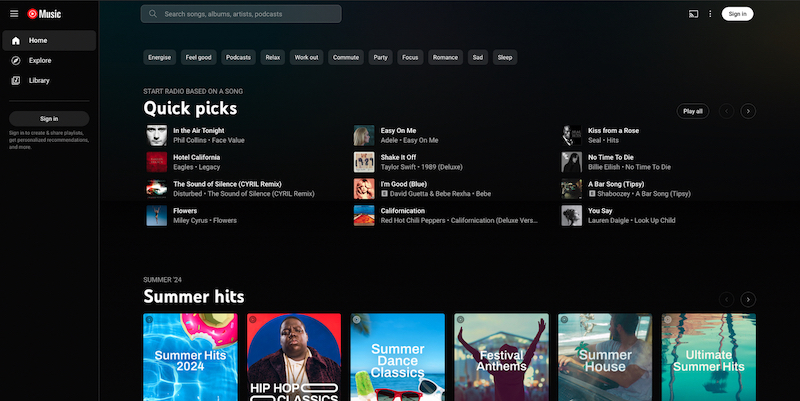
As of mid-2024, Amazon Music has an estimated active listener base of about 82 million, and YouTube recently breached the 100 million mark (although, these numbers are fluctuating constantly). These numbers aren’t minuscule by any measure, however, still don’t compare to the likes of Spotify, and most of the users who choose to listen on these platforms do so out of convenience's sake because they already have ties to the parent platforms.
Aside from this, both platforms lack advanced features, such as an artists app, or profile management/customisation. Overall, releasing your music to these platforms may help you extend your reach slightly, however, you won’t have as much control over how your fans experience your art.
Pros of Amazon Prime Music and YouTube Music
• Lossless audio quality (not quite on par with Tidal)
• YouTube Music allows you to add your own audio ads between tracks to generate revenue
• Higher revenue per stream than Spotify
• Access to decent-size listener base across both platforms
Cons of Amazon Prime Music and YouTube Music
• Audience reach is not as easy for artists to achieve via these platforms (minimal shareability and promo tools)
• Standard features compared to Spotify and Apple Music, with little to no customisation of Artist profiles.
Beatport
Founded in 2004 as the principal source of music for DJs, Beatport today is the worldwide home of electronic music for DJs, producers and their fans. With a global footprint of over 45 million unique users, 456 thousand DJ customers and 11 million curated tracks supplied from 75 thousand label partnerships, the platform is a bustling community for both creators and fans. If you produce electronic music, you need to make sure that your tracks are distributed on Beatport!
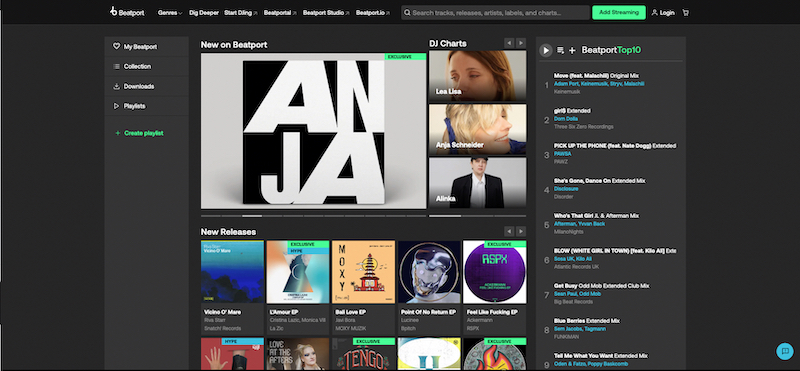
The Beatport Store offers music in premium digital formats and provides unique music discovery tools created for and by DJs. Each week, Beatport's music collection is refreshed with hundreds of exclusive tracks by the world's top electronic music artists, as well as fresh playlists appearing regularly in the form of DJ Charts. Your tracks can also end up on editorial curations like 'Best New Tracks', 'Staff Picks', 'Beatport Next' and 'Amplify Diversity', placing your music right under the noses of a huge, receptive audience.
The main purchasing option on Beatport is buying tracks individually, which as an artist will net you much more than the micro amounts generated from streaming revenues. Like other services such as Spotify though, Beatport also have a multi-tiered subscription model that essentially allows DJs the ability to "audition" full-length tracks in their DJ apps at lower bit rates, which in turn generates streaming revenue for artists. These two revenue sources mean that you can be well rewarded for your tracks on Beatport, while also benefiting from the strong communal aspect of both DJ culture, and the site itself.
Pros of uploading to Beatport as a streaming service
• Provides a strong community for electronic music producers, creators, and fans
• Offers premium digital formats and unique music discovery tools
• Music collection and playlists are refreshed weekly with exclusive music and tracks to increase distribution
• Increased opportunity for generating revenue with tracks being bought individually and multi-tiered subscription models
• Get your music in front of DJs and other music heads
Cons of uploading to Beatport as a streaming service
• Mainly aimed at DJs and electronic music enthusiasts, so may not be a suitable option for all musicians or creators
Bandcamp
One that should be on the radar of any artists releasing music today, Bandcamp promotes exploration through its by-the-second feed of platform sales on its homepage. The feed promotes the value of music by displaying the price that music sells for – great for visualising hype or discovering hidden gems. Landing an editorial spot on Bandcamp's homepage that recommends exciting new releases and live streams can prove a lucrative place to showcase your music.
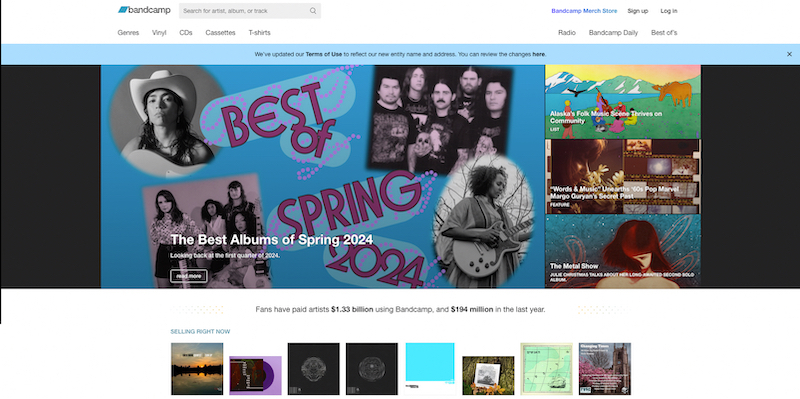
Bandcamp clearly has an ethos that’s driven by musicians. In 2024, Bandcamp are continuing their Bandcamp Fridays program, which boasts that on the first Friday of every month, 93% of customers' money goes directly to the artist. It’s 82% any other day of the month – not bad to begin with! The site allows you to decide how much your material, merchandise and physical copies of your music are worth. Take control of your brand by customising the aesthetic and pinning your favourite reactions and reviews to display next to your tracks.
With such a focus on the musician, though, Bandcamp’s weakness may be its smaller appeal to those listening to and buying music. This makes it a non-convenient platform to visit for every average listener, who’s used to streaming their music on Spotify, or other industry giants’ platforms. How that changes the equation for your revenue is a matter specific to you. If honed correctly, Bandcamp can be a useful marketplace to tap into.
Pros of Bandcamp distribution for musicians
• Promotes discoverability and exploration with a constantly updated public sales feed
• Higher financial return for artists with 82% of the money going to artists, and 93% on the first Friday of every month
• Artists can take control of their brand by choosing prices and customising displays
Cons of Bandcamp distribution for musicians
• Less of a focus on community and interactivity with fewer discovery algorithms for artists to benefit from
• Small/niche consumer-base
Soundcloud
Maybe it’s also time to reconsider SoundCloud. Although it may not be a household name for music listeners, the platform is famous for being a home for grassroots artists. SoundCloud made big announcements to upgrade its services for emerging artists. These announcements pricked up the ears of many, revealing collaborations with Splice and Pandora that put the platform back on the map as a streaming service offering new artist development plans and playlist opportunities.
Indeed, SoundCloud stayed true to their promises, and both of the collaborative announcements were implemented with SoundCloud x Splice launching their Nova program, and SoundCloud x Pandora launching their The Lookout by Soundcloud program. The Nova program starts with competitions for producers and artists to take part in and then releases unique sound packs based on the sonic style of 12 winners. The Lookout by SoundCloud program is a scouting effort to help identify emerging hip-hop artists on the platform and get them onto a custom station on Pandora radio.
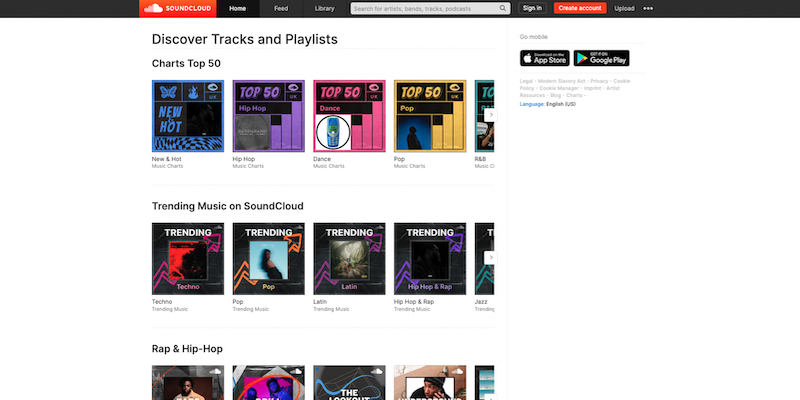
Aside from this, SoundCloud have implemented a few different subscription tiers for artists over the years that provide you with some nice audience statistics and profile customisation options. SoundCloud have worked hard to adapt their platform to the ever-changing music consumption climate, and they’ve even implemented their very own SoundCloud for Artists page to compete with the likes of Spotify and Apple Music. The only downside to using these advanced SoundCloud features is that you need to pay a fee for a subscription tier, making it one of the only platforms you need to pay for as an artist to access the features.
Of course, SoundCloud still upholds its traditional shareability features that made it popular in the first place (a fan-to-fan reposting system, with the ability to like and comment on tracks). SoundCloud now provides all of these traditional features, plus provides creators with advanced sharing features (such as playlists, Nova, and The Lookout by SoundCloud), the ability to monetize your music through streaming royalties and ads. And, the service also tracks artist fanbase and provides detailed statistics on plays, downloads, and audience feedback.
Overall, SoundCloud probably has more features than all of the streaming platforms mentioned so far, so it's definitely a viable marketplace for you as a musician.
Pros of uploading music to Soundcloud
• Allows artists to track fanbases and detailed statistics on listens, downloads, and feedback
• Offers new artists' development plans and playlist opportunities to increase discoverability
• Collaborative discoverability programs with Splice and Pandora
• Great by-the-community-for-the-community platform
Cons of uploading music to Soundcloud
• Largely known as a home for grassroots artists and has a smaller number of users than other platforms
• Can be a difficult platform to gain traction on
• Have to pay to access most of the advanced artist features
How to decide the best music streaming service for you?
After reading our thoughts and the recent performance of these streaming services, we hope you’ve gained more insight towards being able to make a decision. Everybody will have different priorities to factor into any decision. For instance, some may be looking to make money from the service, while others may be looking to spread awareness and gather fans at the expense of direct royalties.
To help you focus your thoughts on exactly what factors are and are not a priority in your decision, consider the following…
What genre of music do you make?
Different genres have different fan bases, different listener demographics and different general expectations. Some genres appreciate old-school nostalgia and afford more opportunities to make money with vinyl pressing than Tidal uploading! This may not factor into your decision, but it’s worth a quick thought, mostly about where your audience will expect to find you.
What’s the size of your fanbase and existing reputation?
Have you spent years building up your reputation, with gigs in every town and dedicated fans in the scene of every underground? Or are you just getting started and are looking out for fans? Then this may affect your choice of streaming service.
For those with an existing reputation and following, Bandcamp may be the way to go – especially at the initial phase of a new release. Anyone without an existing fan base or following will prefer to take advantage of ‘being discovered’ on platforms with strong curation.
What sort of fans and listeners are you seeking?
Again, consider the target audience of the music you make. Where do they live? How old are they? And of course, what streaming service do they tend to use? It’s worth noting that your ‘target’ audience and ‘actual’ audience may be different, so try to use data where you have it rather than just trusting the profiles you have in your head.
How big is your existing catalogue?
If you’ve got years of releases behind you, especially if fans have already paid for these in the past, streaming could provide you with enough plays to make a dent in your wallet. If a fan once bought an album on CD, digital download or any other way, then streaming offers a way for them to pay even more today!
Do you value revenue per stream or number of streams?
A platform like Bandcamp may pay you more per stream, but Spotify holds the vast majority of listeners and listens. It’s possible that this extra volume may actually beat the revenue offered by Bandcamp, but this depends on the artist, their efforts, and their pre-existing fanbase.
Do you have another source of revenue as an artist?
If you stand to make money through live events, physical album or merchandise sales, or any other route, then streaming revenue may not be the key factor for you. If streaming numbers get more people to your shows and provide you with money in other ways, then your priority should be discovery and not immediate revenue.

